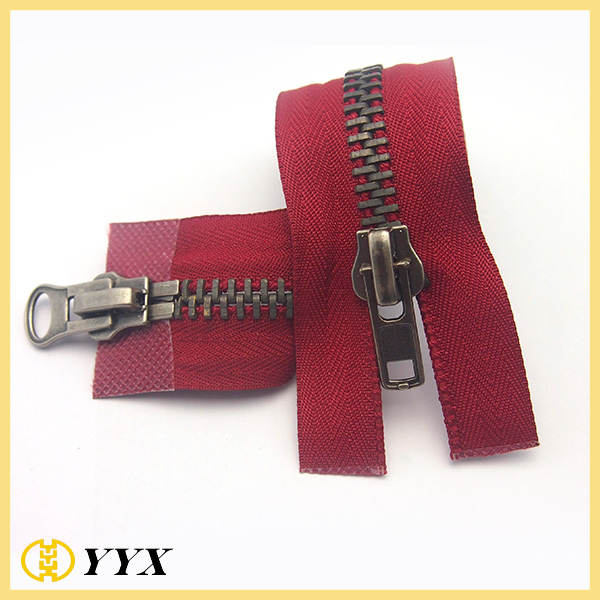Metal Zipper
Metal zipper zipper belongs to one of the microphones refers zipper teeth made of copper, aluminum or copper-nickel alloy material produced zipper, resin zipper and Nylon Zipper compared in terms of, more durable, and more for jeans, jackets and backpacks.
Features: Rugged, higher cost
Divided according to the size: # 3, # 4, # 5, # 7, # 8 and so on, depending on the size microphone size zipper teeth change. Because it is often used in the jeans, jackets and backpacks, so its dimensions are larger zipper.

classification:
1. TYPE: closed zipper,
Opening zipper (detachable),
Double closed end zipper (X- zipper with double slider zipper with two opposite or O- double slider two opposite), double open end zipper (Inverse open detachable)
2. Mi tooth Material: Existing material type of aluminum, brass, copper-nickel alloy, zinc alloy. Color metal microphone teeth often as needed electroplated, such as aluminum plated microphone yellow teeth, tooth-plated brass microphone white, black nickel, bronze, red bronze, gold and other colors.
Metal zipper Composition:
And other similar zippers, metal zippers composition is formed by a cloth belt, microphone teeth, slider, limit codes.
Tape: Material generally fiber belt, cotton or polyester fibers with a belt, can choose different materials depending on the application.
Mi teeth: the market for the production of metal zipper and more aluminum, brass, copper-nickel alloy, zinc alloy and other materials made of, since the color on the metal zipper teeth are plated microphone up, if improperly stored, the teeth will turn black microphone clothing and would cause pollution. For microphone tooth copper alloy is prone to oxidation, so when you save to ensure a certain degree of ventilation, do not sealed, do not save in the moisture-laden environment, if necessary, have to use the moisture-proof paper or desiccant.
Slider: metal slider respectively bronze color, red bronze plating, white, yellow-plated, black nickel, black nickel, matte silver, under normal circumstances, the color of the metal slider requires a microphone with a metal zipper teeth the same color. According to regulations, common slider parameters are:
3 # metal slider opening height of 2.1-2.2mm, mouth wide as 4.55-4.65
5 # metal slider opening height of 2.7-2.8mm, mouth wide 6.0-6.05
Limit code: divided into upper stop (front yard) and bottom dead center (post code). The main role is to prevent the upper and lower retaining slider from microphone teeth.
Note:
In the garment washing or processing time, pay attention to:
A wool knitwear after being ironed, to ensure adequate cooling can after zipper packaging, otherwise,
After the metal zipper will react with steam generating, easy to change color. Second, in the clothing trade processing, it tends to remain certain chemical reagents, then it is easy to react and metal zippers. Therefore, prior to assembly of metal zippers, leather has been the need to ensure adequate for cleaning and neutralization.
remind
Since there are different zip adaptability in different environments, so in the selection and purchase of the zipper when you choose must inform the manufacturer of the zipper on the application in which products, and manufacturers have to inform you of the fastener component requirements, such as You can be a pin detection and so on. Further, generally prohibit the use of azo dyes in the composition, as the dyed fastener after contact with body induce certain diseases.
Maintenance tips:
First, the science of using a metal zipper:
1, when the metal zipper pull, it must be close to both sides of the tooth, must be aligned to the top, then head down the track holds metal zipper pull gently, not too much force to pull.
Metal zipper
Metal zipper (2)
2, when moving the metal zipper should be careful not to hem skirts or other debris caught in the metal zipper in order to avoid "crooked teeth", "belly", "off the teeth" and so on.
3, if the metal zipper astringent, not easy to pull, do not dead lift, put some wax or soap on top of a metal zipper, you can pull.
4, if the metal zipper teeth unilateral differences rope, wear loose hair, available in popular tiger clamp closed end of the metal zipper lateral gently clip, metal zipper immediately changed for the better, unilateral teeth together tight, no broken loose.
Second, to prevent metal zipper moisture, oxidation, rust and discoloration.
1, to avoid contact with the moist environment: because the metal zipper metal oxide due to the dip caused by tooth portion has a black phenomenon.
2, avoid contact with rubber band: Because rubber band itself contains sulfides, when bundled with rubber band metal zipper, metal chain teeth will have vulcanized phenomenon (black).
3, should be cleaned and dried after washing with water: because the fabric dye or residual chemicals and metal parts redox reaction, metal parts may cause discoloration.
Cause of Color Changes
a, copper alloy (copper-nickel alloy, copper, brass) made of metal zipper discoloration of reasons:
When used in the metal or hair products, metal zippers metal due to oxidation caused most of the teeth have a black phenomenon. This is because when the bleach manufacturing process of cooked skin leather woolen products agents on the process and remains in the product, the product gas can cause discoloration of the metal zipper.
Examples of chemical reactions: oxidizing bleach (H2O2) → black (CuO) or red (CuO2);
b, rubber bands bundle of metal zipper color reasons:
Rubber band itself contains sulfides, when the rubber band bundle metal zipper, metal chain teeth will have vulcanized phenomenon (black).
Chemical Reaction Example: excess gas sulfides or HS2 conditions → black [CuS]
c, contact with an acid or chromium compound causes discoloration.
Chemical Reaction Example: acidic compound and chromium compound [Cr2O3] → Black [CuO, red [CuO2] or blue [CuSO4].
*Related Products:brass zipper,gold metal zipper,#5 metal zipper,metal zipper for jackets,brass zippers wholesale,gold zipper,antique brass zipper.
Zipper Metal,Metal Zippers,Zippers Metal,Metal Zip,Roll Zipper
Shenzhen Yiyixing Zipper Manufacture Co.,Ltd , https://www.yyxzip.com